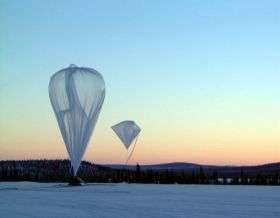Mars technology on balloon to study the atmosphere

“From Mars to the Earth and back” is the theme when the Swedish Institute of Space Physics (IRF), the Swedish Space Corporation (SSC) and University of Bern in Switzerland build and launch a mass spectrometer on a stratospheric balloon from SSC’s operational facility Esrange Space Center in Kiruna.
The project is called MEAP (Mars Environment Analogue Platform) and will be carried out during the summer of 2008. MEAP is a test mission to try out new technology (the mass spectrometer P-BACE, Polar Balloon Atmospheric Composition Experiment), which has primarily been developed to conduct a number of measurements on Mars during forthcoming missions. The test project MEAP will be carried out in the Earth’s stratosphere, an environment that has many similarities to the conditions at the surface of Mars.
Prof. Stas Barabash at IRF emphasises the scientific significance of the project: “It is an exciting project that will play an important role in the development of similar instruments for planetary and atmospheric research, particularly on Mars but even on Venus. The mission will also strengthen the collaboration between the two largest space organisations in Kiruna, IRF and SSC.”
The MEAP project will even help to extend the range of balloon flights from the Esrange Space Center. Circumpolar flights during the winter, when the winds in the stratosphere blow from the West, have been performed from Esrange Space Center for many years. Winter flights involve polar darkness which is advantageous for certain measurements that are sensitive for extraneous light. Now it is time to offer the same thing during the summer months when the winds in the stratosphere blow from the East. Summer flights occur during a period with midnight sun when the sun can provide renewable energy for the experiment via solar panels, something which is often necessary during long flights.
If all goes according to plan the balloon with fly with the help of the summer polar vortex at a height of 30-40 kilometres and land about a week later in Canada or Alaska. Dr Olle Norberg, manager at Esrange, SSC, has a strong belief in this summer’s flight and looks forward to the time when these flights can also be extended further, into circumpolar flights round the North Pole. That will be the next step in the development of balloon activities. SSC is already working to obtain permission to fly over Russia.
“Circumpolar flights are in great demand by scientists from around the world,” says Dr Olle Norberg. “Scientists want to perform longer measurements both during the summer and the winter. The opportunity to fly balloons right round the North Pole would in all likelihood greatly increase the number of balloon flights from Kiruna.”
Source: Swedish Space Corporation





















